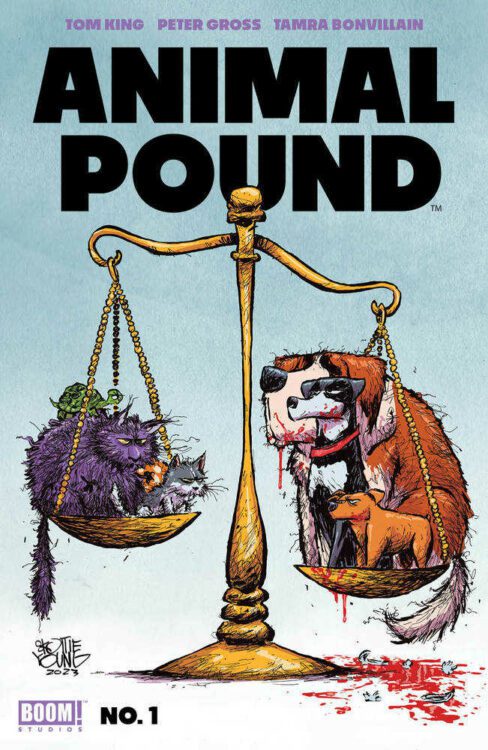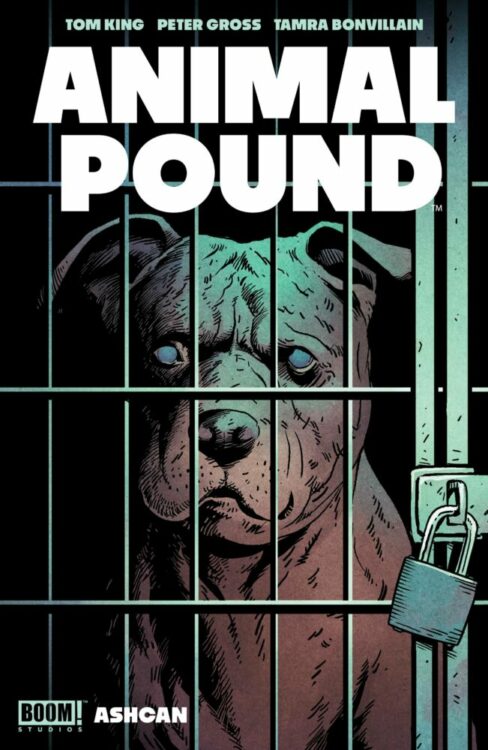“Now, please, young one, hear me, for soon I shall speak no more.” Lucky the dog is not as well off as his name would suggest. No, in the opening scene of BOOM! Studios’ Animal Pound #1 — written by Tom King, with art by Peter Gross, colors by Tamra Bonvillain, and letters by Clayton Cowles — Lucky is waiting to be taken to a room marked with a sign that simply says “Animal Disposal.” In his last moments, he calmly speaks to Fifi, a curious kitten who has made a hole between her cage and his, telling her all he’s learned about dogs, cats, rabbits, and man. And so, our story of revolution and change begins with a whispered manifesto. In the spirit of George Orwell’s masterwork Animal Farm, King, Gross, Bonvillain, and Cowles bring us a meditation on power, wealth, and class — tweaked and remixed for a modern audience.
About Animal Pound #1:
When animals grow tired of being caged, killed, and sold off-it’s only a matter of time before they’ve had enough…
When an uprising puts a pound in control of the animals, they quickly find themselves as comrades, united against everything that walks on two legs.
But with this newfound power comes a sudden challenge: how best to lay the groundwork for this new democracy as they write their first constitution!
Writing
One of the most interesting things to keep in mind when reading King’s script is that he’s writing in a vastly different environment than Orwell was. Orwell wrote his book to condemn Stalin’s commandeering of socialist ideals towards totalitarian ends. He was describing allegorically, with the help of his pigs and horses, how the Soviet Union had corrupted the effort to live as a community of people who looked out for each other. Orwell, himself, was a democratic socialist. King, however, is writing in a time and place where the word “socialism” is automatically heard as “communism” by many. And yet, this is also a time and place where capitalism has started to show some ugly cracks in its foundation. Every other week we hear about yet another billionaire planning to use his wealth for some vanity project, all while finding elaborate ways to avoid taxation. And so King has an interesting task ahead of him. How does he give us hope that the world could be better, just as Animal Farm suggests at first, while warning us of the pitfalls we must avoid along the path?
If you read Animal Pound #1 with all of that in mind, you won’t be disappointed in the slightest. The whole allegory immediately contrasts itself to Animal Farm in a few important ways, while keeping Orwell’s complex balance of hope and dread intact. The most obvious difference, of course, is the setting. Where a farm is lush, bountiful, and open, an animal pound is bleak, dirty, and closed off. “The doors, you see, the doors,” Lucky the dog says in his final moments. “We spend our entire life staring at the door, scratching at the door, howling at the door.” That’s the difference he sees between animals and men. Men can open a door, while animals have no hope but to break it down.
King narrates much of this script in poetically descriptive language. Sounds aren’t just loud, they’re a “cacophony.” A kitten doesn’t simply describe a dog as mean, but “ornery.” Cats and dogs have really never spoken so eloquently. But all of that beautifully lends itself to the charm of this first issue. King wants you to know that this isn’t just an animal speaking, this is a character with a heart and soul. These characters have dreams just like anyone of us. Mostly, they dream of freedom.

Art
Gross’ ability to show an animal actually emoting is unrivaled. When a bulldog is called on to make the first move in an elaborate plan, Gross draws him with nervous eyes. You can almost see them darting around between panels. But while this is a very dramatic story, with incredibly high stakes, there is still a wonderful subtlety to these pages. When we first see Lucky, for instance, he doesn’t look very emotional. He’s resigned to the approaching end of his story. When he’s been taken away, his feline confidante’s face is blank. We can’t tell if Fifi is feeling sad or resolved.
Much of the way Gross designs his page layouts speak to the tone of each scene. When the cats and dogs are locked away in their cages, the page looks ordered and contained. The panels stack neatly on top of one another in organized rows. There’s no resistance to the norm that man has put in place. The animals aren’t trying to break out of their bonds, but instead sit meekly between the gutters. Later, when the chaotic coup begins, the pages erupt into pandemonium. One dog howls, his snout jutting past the outline of the panel he’s occupying. The ears, noses, and paws of the rebels all refuse to be kept in check, as the panels tilt and twist. When the animals begin to try and bring about their own brand of order, the page obediently falls back into a tidy rhythm. Gross leaves us wondering what it is that will set the beasts apart from their previous masters. Will they simply replace one tyranny with another?
Coloring
Bonvillain’s coloring feels deliberate and symbolic. While there are plenty of warm colors, often seen in the furs and flesh of our cast — orange tabbies, brown beagles, and the pink noses of kittens — everything seems to be cast in the cold, blue light of the pound. The men, who come in as guards and occasionally as bearers of food, wear blue uniforms. The dogs’ collars, the sofas in the entryway, even the cages, are all blue. It’s interesting, then, that it’s with blue paint that the beasts decide to spell out their new manifesto. It’s just a can that they found leftover in a closet, but its hue has begun to take on a certain meaning at this point in the story. Bonvillain seems to be wanting us to ask those same questions Gross left us with. Can the animals really do much better building a society when they’re left with all the same tools that man had?

Lettering
The small, specific choices that went into Cowles’ lettering makes all of the difference in the story. When the uprising begins, Cowles lines the bottom of every panel with the jaggedly lettered sound effects of desperate barking. When a cat screams, its letters are still big and messy, but they’re written in a more slender font to help us hear the sharpness of the noise. But it’s actually one of the most understated moments of this issue that shines the brightest. When Fifi and a dog are talking about the fateful day that’s approaching them, it’s clear they’re both feeling very differently about it. Fifi’s word balloons have an uneven outline to them. The first of them has a tail that wanders along, snaking lazily towards her mouth. When the dog speaks, his word balloons are neat and straightforward. He’s alert, even nervous, while Fifi is as relaxed as the hand that outlined her dialogue. But right before they both go to sleep, Fifi’s final words are written in a normal balloon. She’s assuring the dog that she’s as much a part of this as he is, and she’s ready for what comes next.
Conclusion
The best thing about Animal Pound is that it’s not just a carbon copy of Orwell’s classic. It would almost be more accurate to call it a modern day response to Animal Farm. It’s brilliant, heart-wrenching, adrenaline-pulsing, and revolutionary. Animal Pound points to the bars of our cage and asks us if we want to be free. But it also wants us to ask what the cost is for change and whether we know how to get change the right way. Animal Pound #1 is out from BOOM! Studios the 20th of December at a comic shop near you! Don’t miss it!

